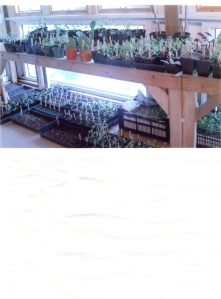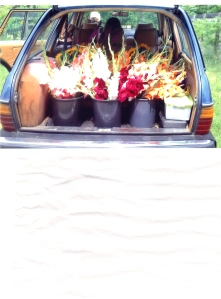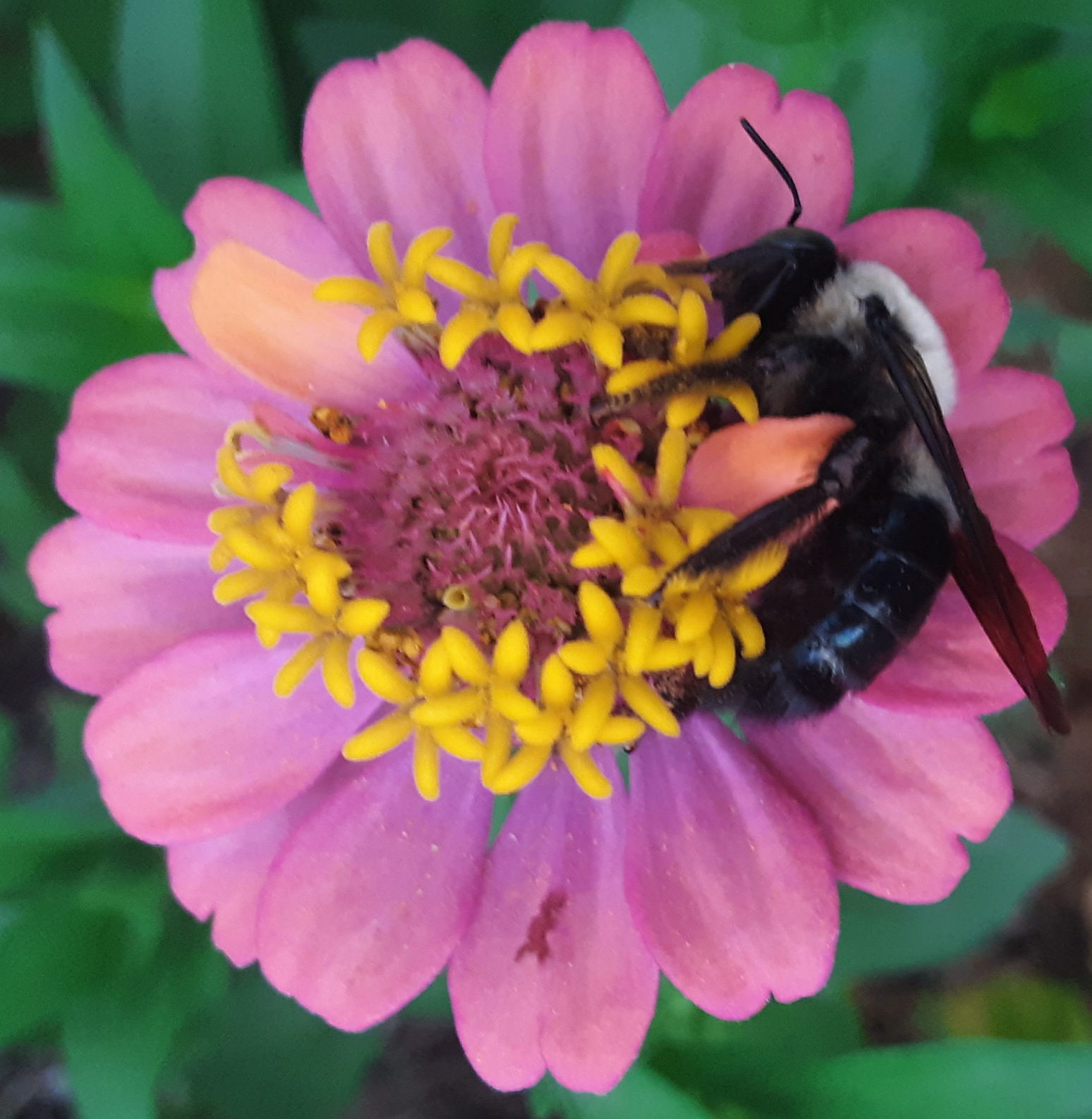
One gorgeous day last Fall, my youngest daughter Jasmine and I took a trip an hour south to Farmville for an open house at a large, diversified farm. There were pastured chickens, a petting zoo, people demonstrating spinning and weaving, musicians, dancers, food, and reps from different farms and farming interest groups, sharing their knowledge about their livestock and crops, as well as programs.
We happened to strike up a conversation with a friendly woman named Cheryl, who was from the extension office of Virginia State University. I remarked on the beautiful zinnia crop the farmers there had produced, and she took note of Jasmine’s name. She then mentioned a program they were facilitating to help more flowers that were sold in Virginia also become flowers that were grown in Virginia. (According to some reports, less than five percent are).
Jasmine was immediately interested; just that same season she’d grown her own beautiful crop of zinnias, cosmos, and coreopsis, and she was hoping to increase her crop size the next year. For me, committing to one more thing beyond our bees, chickens, ducks, and fencing a newly-tripled garden space while homeschooling seemed exhausting enough, without beginning another new project. However, when I remembered our days back in the city fifteen years before (now 20, Ed.) I realized how much I would love to grow flowers as a crop with my family.
Our interest began when we lived on Stuart Avenue by the Virginia Museum of Fine Arts; across from our tidy brick row house and next to the alley was a huge city block-sized St. Benedictine’s. The place served as a Catholic church as well as a school for boys with a military bent, proudly claiming on their bumper stickers that they’d been “molding young men” even longer than the house we lived in had been around, and that house was built in 1920. We liked to joke that they were actually advertising that “moldy young men” had been holed up in there for just as long as the place had been around.
I never took much notice of the boys who sometimes snuck down the alley alongside our house to smoke cigarettes, but it did begin to occur to me that every single Monday morning, their Filipino janitor could be seen stuffing several elaborate, still-fresh flower arrangements into their large dumpster. I rescued a few after he’d left, but one Monday, I mustered the courage to ask him why he was throwing such beautiful flowers away.
He agreed it was a shame, but the flowers decorated the sanctuary for Sunday mornings, which then sat empty for six more days until a new arrangement came and Sunday services began all over again. It would not do to leave the flowers either rotting or drying in there, stinking up the place.
Still, it seemed sad to throw out the Mums, Gerber Daisies, Roses, Carnations, and the florist’s foam and vases and baskets every week, and as he agreed with me, he promised to put them on my porch instead.
I think he was pretty happy to do it and had been waiting for someone to take the flowers home for a while since he’d always waited until late Monday morning to dump them. Now, even when I woke up pretty early (for me) on Mondays to start my week, it was not unusual to find a whole porch of flowers in various forms, waiting for me.

And what a gift it was! These items, though possibly a donation from a wealthy church member, were probably worth at least a hundred a week (in 1990s money), more if you consider the free delivery.
The best part of getting these floral hand-me-downs from the church was the fun they provided for me and my oldest daughter, Ajah, who was about two or three years old at the time. First, we’d bring the flowers in, and remove them from the foam or containers they came in.
Then, we’d set out the flowers in front of us, usually disposing of the foam, and decide what color combinations we liked, and what would look better than the original arrangement (sorry, but for me, a casual country-style bouquet ALWAYS trumps a stodgy formal one, which these all were). Sometimes people would show up, such as friends who had grandmas in the hospital, or who just needed a bouquet. It gave us great joy to make custom arrangements for them, or to allow them to assemble their own from all the flowers and containers we’d salvaged.
Aside from the joy of sharing that which would have been wasted, we got to enjoy fresh flowers for the rest of the week, till they really did need to be thrown out. Unfortunately, we did not have a compost pile at the time because we were afraid of rats, and did not know about self-contained bins. Now we do, so nothing is ever truly “spent.”
At our next home, we had a virtual playground of already-planted lilies, a whole woods’ worth of naturalized daffodils, and several flowering shrubs; there was always bouquet-worthy material. And indeed, once we moved there, Ajah, who now had a couple of years’ worth of arranging experience behind her, brought me bouquets (along with her sisters) almost every day for the five years we lived there. I am not exaggerating: there was always some jar or vase filled with greenery, at the very least.
So, after considering how nice it was to have palettes of flowers to choose from for all those years, and how much fun it would be to assemble bouquets for the market, we decided as a family to take on just one more project. It was a pretty marvelous deal: we were given peony rhizomes and Asiatic lily bulbs in the Fall, and after tilling and adding manure and other amendments, we planted amidst the landscape fabric they’d also provided us.
I felt odd doing both; we’d never tilled before, nor had we used woven plastic to keep down weeds. However, the extension agent assured me I’d appreciate it come next July, and also hinted that it would help flowers bloom sooner, as well as aid the soil in retaining moisture.
In the Spring through the early Summer, we planted dozens of different kinds of flowers: hydrangea, zinnia, sunflowers, lilac, evergreen holly, gladiolas, yarrow, statice, crocrosmia, bleeding hearts, and I don’t-know-what-else.
Somehow, we were able to plant and mulch this mind-boggling array of flowering plants by July, and despite being bedridden for two weeks in late June, the kids and Michael kept things hand-watered for me, since we had no irrigation system (which was originally promised, but fell through).
Once July hit (and I could not move), the gladiolas and sunflowers were blooming their heads off, and Michael and the girls devised a route of florists to visit Charlottesville. The store owners were impressed with the kids’ manners, their professionalism, and the beautiful flowers. I was so proud!
Finally, I was able to get around by mid-July (just before the exchange student arrived) and Jasmine and I set up for the first time at the Farmers Market in Fluvanna. We didn’t make huge profits, but it was fun to get out and meet our farming friends and neighbors, and to have a good reason to buy local food every week.
We also set up mostly at the Scottsville Farmers Market, and though the weather was prohibitively hot for flowers a few times that we skipped, we generally enjoyed our Thursdays, surrounded by the fruits of our labor, neighbors, and the intimate and tantalizing savory smells of Naveen’s wonderful Indian food. If I made good sales, I was happy to bring home food from the surrounding stands.
Aside from getting better at harvesting flowers, prepping, and arranging them, a small crowd would usually form whenever one of the kids assembled our signature bouquets wrapped in green and white tissue paper, wrapped with raffia and a smile. People told us our bouquets made them feel like beauty queens, brides or award winners, and we loved making them feel special.
Unfortunately, by September we were energetically spent, and the hot weather had taken its toll on our crops and the market itself. It was called off early since people just weren’t attending once school started. Any 90-degree day was almost a sure “no sale” day unless we drove to town with its air-conditioned florists to ply our flowers. That is what we did from the end of our first season of sales until frost arrived.
Now, in the cool moonlight of November, where the temps dip into the low 20s by dawn, some of the sunflower stalks remain, and summer is but a sweet memory. We plan on inventorying the plants that survived this past summer’s desert-like conditions, counting the spaces of the 50×175′ field, and ordering more from the colorful catalogs that will begin blooming (no doubt) in early January, in our mailbox. A new year will begin again, and sunny summer will arrive again for us while we do what is surely one of the best jobs on earth: growing flowers like soul food.

